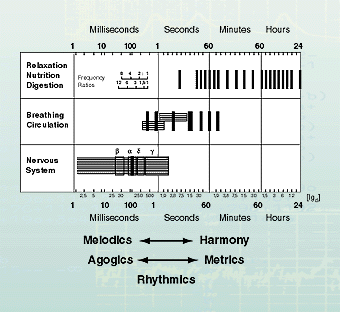| FREIE VOLKSUNIVERSITÄT |
| FREIE VOLKSUNIVERSITÄT |
| SCIENTIFICALLY INTRODUCING UNIVERSALITY TO THE UNIVERSITY |
| . |
. | .Deutsche Übersetzung in Arbeit |
Prof. Dr. med. Gunther Hildebrandt • Chronobiological Aspects of Music Physiology
On the whole, the more detailed investigation of the rhythmic bodily functions show that the basic elements of music can all be found in humans at the same time as functional and organizational principles of temporal structures. They present themselves as a polar field of tension (illustration 20) between regulating metrics and harmonics on the one hand, and independently mobile melodics and agogics on the other hand:

Illustration 20
The frequency pattern of the endogenous-autonomic rhythms in the three functional areas of the spectrum according to illustration 7 and the relations to the basic elements of music (lower part of the illustration).
(According to HILDEBRANDT 1990, amended)